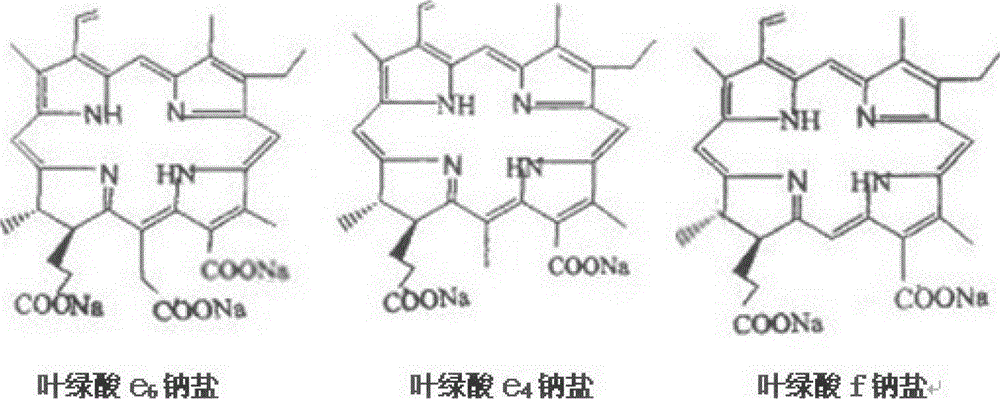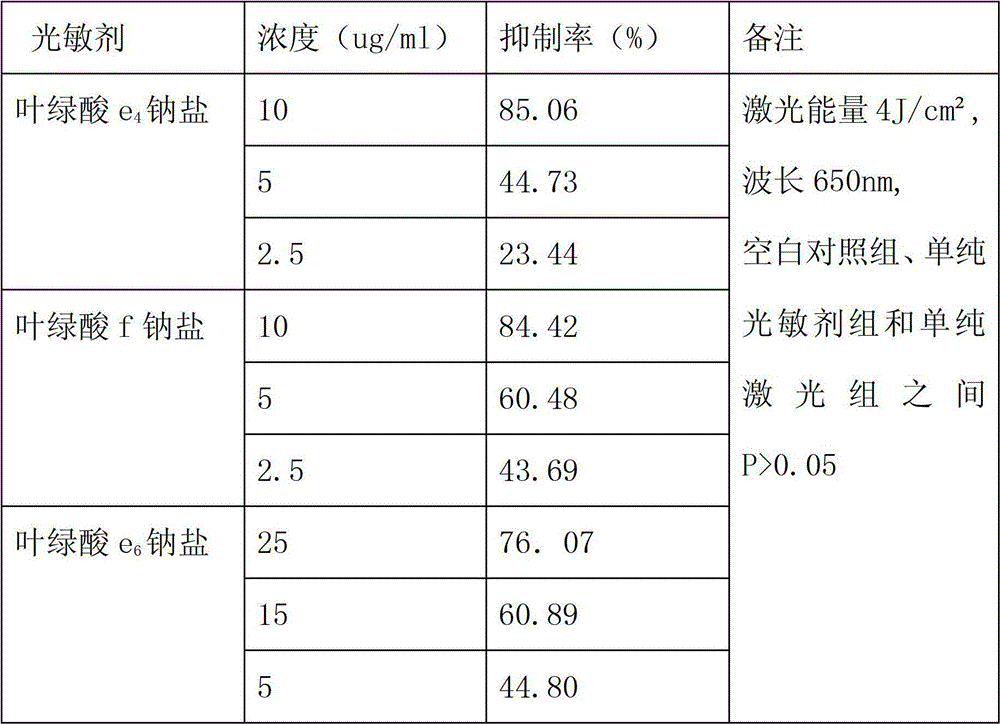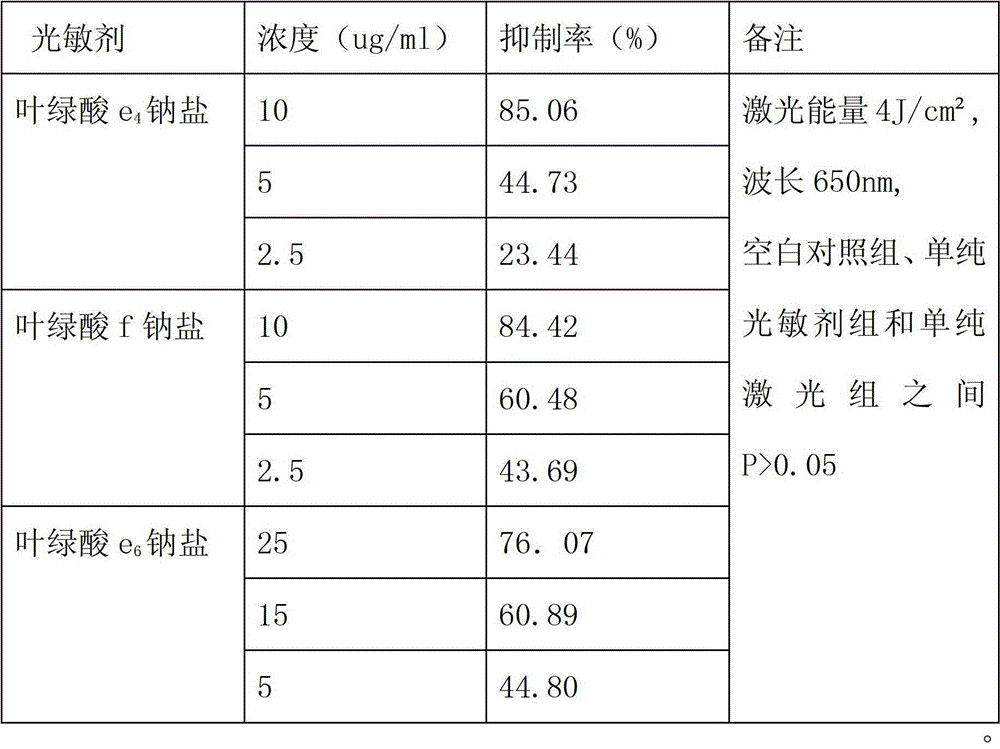Photosensitizer sodium chlorophyllin derivative and its preparation method and use
A technology of sodium chlorophyllin and photosensitizer, which is applied in the fields of photosensitizer sodium chlorophyllin derivatives and their preparation and use, can solve problems such as the limitation of using equipment conditions, and achieve high safety, good curative effect and low toxicity. Effect
- Summary
- Abstract
- Description
- Claims
- Application Information
AI Technical Summary
Problems solved by technology
Method used
Image
Examples
Embodiment 1
[0022] Preparation of chlorophyllin e 6 sodium salt
[0023] Use traditional Chinese medicine silkworm excrement as raw material, pulverize, add 3-5 times the volume of 80% acetone to dissolve, stir in a water bath at 60°C for 2-4 hours, filter, and extract the filter residue twice with 80% acetone, combine the filtrates, evaporate Go to acetone. Adjust the pH of the remaining aqueous solution to 10 with 10% NaOH, extract 3-4 times with an equal volume of purified gasoline, remove impurities, and concentrate to obtain a paste-like crude chlorophyll.
[0024] Take 200g of crude chlorophyll, add 800ml of 80% acetone, stir evenly, add 30ml of 20% NaOH, hydrolyze at 60°C for 60min, evaporate the acetone, let it stand, take alkaline aqueous solution after layering, adjust the pH of the solution with 18% HCl to around 10. Use 400ml of purified gasoline to extract and remove impurities 4 times, filter, and then adjust the pH of the filtrate to 3 with 18% HCl, there is a precipitat...
Embodiment 2
[0031] Preparation of chlorophyllin e 4 sodium salt
[0032] Get the chlorophyllin e that the method described in embodiment 1 makes 6 5g, dissolved in 100ml of pyridine, refluxed with nitrogen in an oil bath at 120°C for 60min, evaporated the pyridine under reduced pressure, added 200ml of water, adjusted the pH to 3 to obtain dark green crystals, dried in vacuum, filtered the precipitate, and obtained chlorophyllin e 4 4.32g.
[0033] chlorophyllin e 4 The TLC identification, the mensuration of HPLC retention time and the result of mass spectrometry are as follows:
[0034] TLC: Rf=0.53
[0035] HPLC: Rt=6.632min
[0036] MS m / z:554(M+H+1) + , 553(M+H) +
[0037] chlorophyllin e 4 5g, prepared chlorophyllin e 4 Sodium salt (e 4 Na), method is the same as embodiment 1, obtains 5.04g.
Embodiment 3
[0039] Preparation of chlorophyllin f sodium salt
[0040] Get the chlorophyllin e that the method described in embodiment 1 makes 6 5g, dissolve in 100ml of pyridine, add 250ml of 25% KOH methanol solution, and let it flow for 60min under the condition of oxygen. Reflux for 60 min under nitrogen, distill off pyridine under reduced pressure, add 200ml of water, adjust the pH to 3 with 18% HCl solution, and precipitate out. The crystals were collected by filtration, washed with water, and dried in vacuum to obtain 4.0 g of chlorophyllin f.
[0041] The TLC identification of chlorophyllin f, the results of HPLC retention time determination and mass spectrometry are as follows:
[0042] TLC: Rf=0.65
[0043]HPLC: Rt=8.532min
[0044] MS m / z:550(M+H+1) + , 539(M+H) + , 538(M+H-1) +
[0045] Take f5g of chlorophyllin to prepare f sodium salt of chlorophyllin (f·Na), and the method is the same as in Example 1 to obtain 5.02g.
PUM
 Login to View More
Login to View More Abstract
Description
Claims
Application Information
 Login to View More
Login to View More - R&D
- Intellectual Property
- Life Sciences
- Materials
- Tech Scout
- Unparalleled Data Quality
- Higher Quality Content
- 60% Fewer Hallucinations
Browse by: Latest US Patents, China's latest patents, Technical Efficacy Thesaurus, Application Domain, Technology Topic, Popular Technical Reports.
© 2025 PatSnap. All rights reserved.Legal|Privacy policy|Modern Slavery Act Transparency Statement|Sitemap|About US| Contact US: help@patsnap.com



